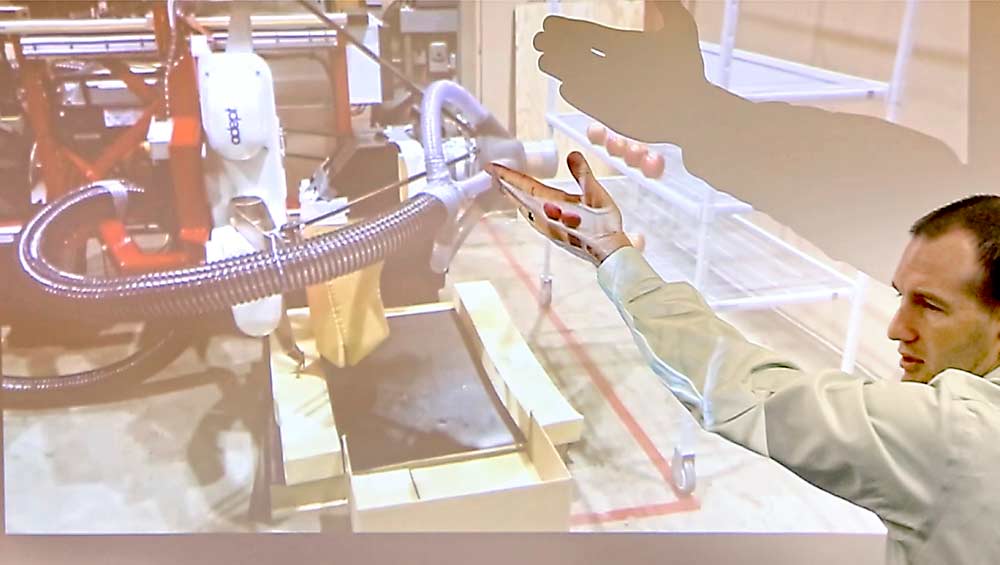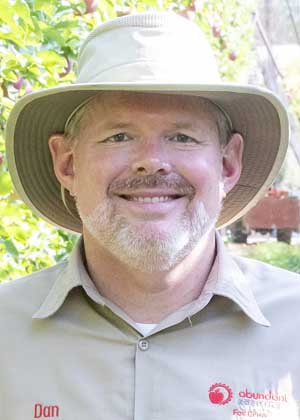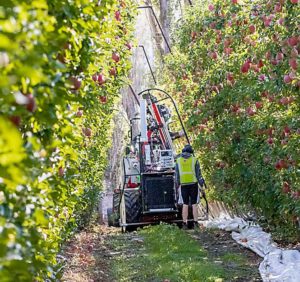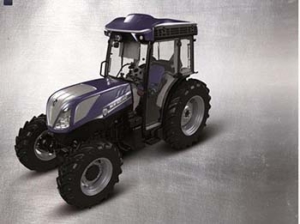
As robotic pickers, computer learning sensors and self-driving sprayers work their way into the tree fruit business, growers need to pony up for incremental developments and accept some risk in that investment if they want those new tools to continue to get better.
That’s how Mel Torrie, CEO of Autonomous Solutions, views it.
Torrie knows the barriers to commercial implementation. His Petersboro, Utah, company spent two decades with John Deere and Case New Holland developing a driverless tractor to fit within the narrow rows of specialty crops, only to have it scuttled by attorneys worried about liability. The tree fruit growers he worked with in Washington, a state that allows automated tractors, still can’t access the machinery.
“They can see it in the museum,” he said, referring to the John Deere Tractor & Engine Museum in Waterloo, Iowa.
Torrie urges growers to view themselves as partners in technology development, meeting manufacturers in the middle to help hurdle some of the common obstacles. And, he sees three ways they can help:
—Share the responsibility for safety and liability. Negotiate contracts with companies that promise to adequately train workers, leave safety functions in place and hold them harmless in the event of an accident.
—Prioritize the wish list. Developers cannot solve every problem at once. Waiting to purchase, until the machine does everything, is unrealistic.
—Find ways to put up some money to give developers financing flexibility, such as pooling with other growers to pay half the price up front. Those arrangements create partnerships to see the technology through incremental improvements.
Torrie is a frequent visitor to Washington State University’s Center for Precision and Automated Agricultural Systems and shared some of these ideas at the center during a presentation last year.
Agricultural and food technology does not lack investment: Startups are flush with venture capital funding trying to find new solutions. The category raised nearly $20 billion in venture funding across 1,858 projects in 2019, according to a report by AgFunder, a Silicon Valley venture capital firm. Of that, a record $7.6 million went to supply chain and on-farm startups.
However, venture capital funding comes with strings, Torrie said. The investors often want to be paid back on a short timeline and pressure developers for ways to do it. He has had to turn down requests to sell data collected from his prototypes.
“We need to find money that is not trying to exit,” Torrie said, referring to the need for longer-term investment.
So, his company shuns venture capital, instead creating an agricultural company with strategic investors who get a share of equity through vertical growth instead of cash payments upon exit.
Response and responsibility
Torrie is asking a lot of growers, said Sky Johnson of Yakima, Washington. Last year, he opened a company called Orchard Door that helps production companies vet new forms of technology, playing matchmaker for developers and users. Growers can’t afford to change everything about the way they operate and can’t “hold the hand” of developers during a busy season, he said.
He envisions agriculture service and product companies — such as G.S. Long and Wilbur-Ellis — stepping up as the end-user for expensive forms of technology. But the developers have to ask the questions and do most of the work.
“The startups, they’re really the ones that have to learn a lot of unknowns that growers know,” Johnson said.
He has his eye on two automation companies for a potential role in the fruit industry: TerraClear, a rock removal platform from Bellevue, Washington, and FruitSpec, an Israeli crop estimation company.
Cody Bishop, orchard technology and process manager for Price Cold Storage and Packing Co. of Yakima, agrees about prioritizing needs. Technology often sounds so cool, growers can get caught up in imagining all the possibilities.
“I think a lot of times we get distracted,” he said.
He encourages growers to not just be open to ideas but be willing to try them out for a season, leaving plenty of time for trials and tests.
Meanwhile, he implores technology companies to truly listen, spending time in orchards with foremen and tractor drivers.
In what he calls a good example of collaboration, labor tracking software vendor PickTrace added functions to calculate average piece-rate wages and costs per acre in real time. “That was from grower feedback,” he said. (Bishop moonlights as a consultant for PickTrace.)

Dan Steere, president of Abundant Robotics, thinks Torrie assigns too much responsibility to growers.
“Most people can’t tell you they want something they haven’t seen,” he said.
Growers just need to be open-minded, and the fruit industry has been, said Steere.
Abundant Robotics of Haywood, California, has been developing a robotic vacuum apple picker for many years. Through the Washington Tree Fruit Research Commission, growers have contributed a total of $650,000 to the development of the robot. In comparison, venture capital firms contributed more than $19 million, Steere said.
However, Abundant’s custom harvest business model lowers the financial barrier for growers to participate and support the incremental improvements Torrie favors. The company does not plan to sell its machines but rather to contract them out as a fleet with an operator. Abundant has only one prototype so far, but growers have been hiring the company the past two years for small-scale commercial trials.
Dave Allan urged growers to continue to develop their canopies to keep fruit accessible to tools such as Abundant’s harvester and FFRobotics, an Israeli company that is also developing a robotic picker — something the research commission included in its list of priorities for apples this year. The former orchard manager for Allan Bros. of Naches, Washington, sees more room for industry groups to come up with a standard evaluation system for tree architecture as it relates to automation.
He also implores growers to look past sticker shock.
“Quit asking how much the machine will cost,” Allan said. “That’s not the question.”
For new pieces of equipment, the market will find the right price point that respects the value proposition to the industry, he said. People purchase smartphones even though they are expensive, for example. Cellular service providers fold them into the cost of contracts. The point is, the value is high enough that the market figures it out.
“We’ve got to get used to that,” he said.
—by Ross Courtney








Leave A Comment